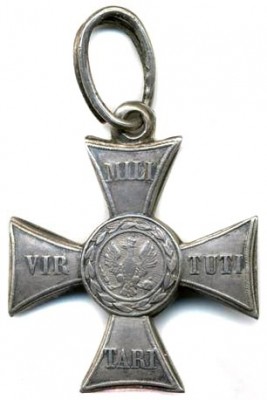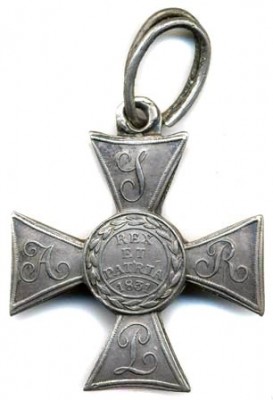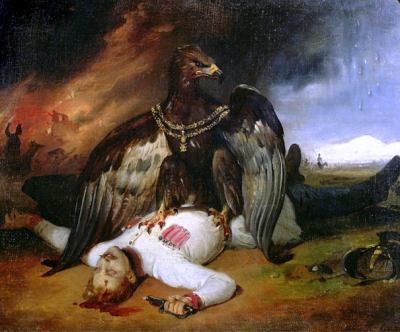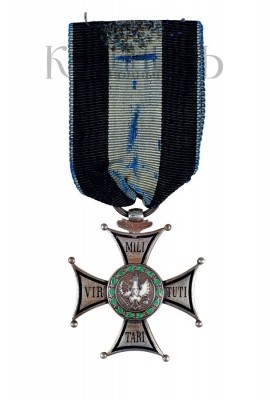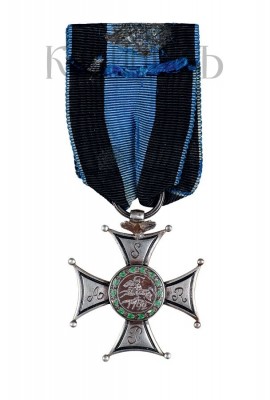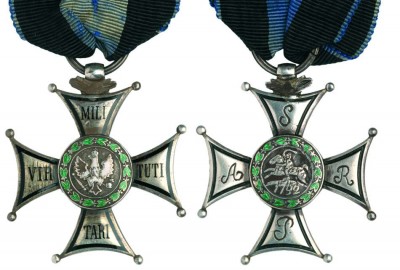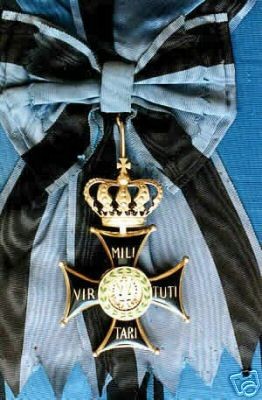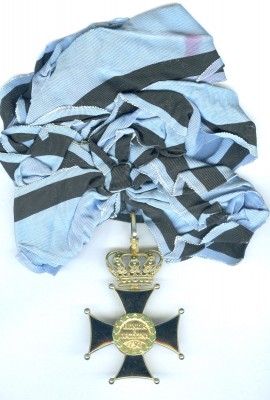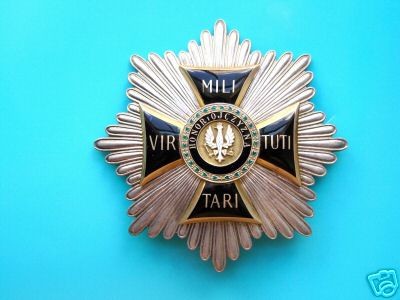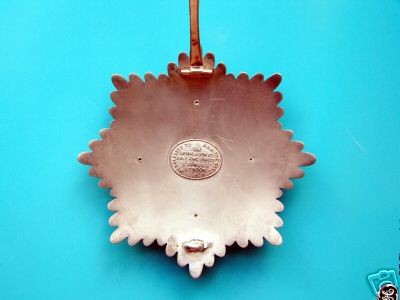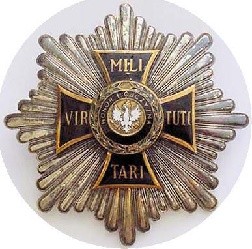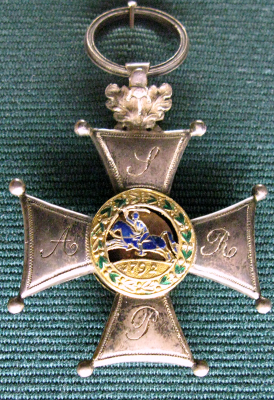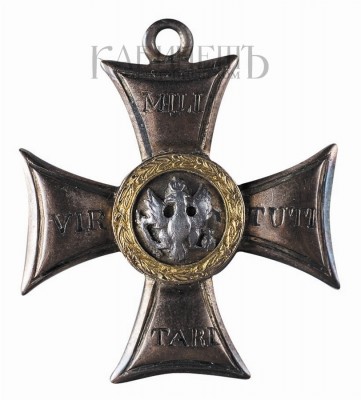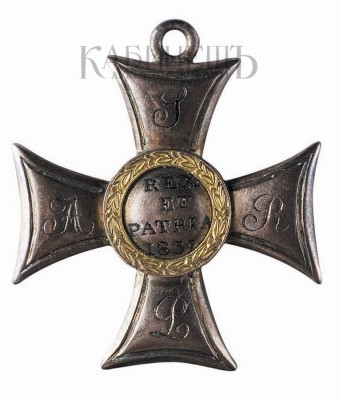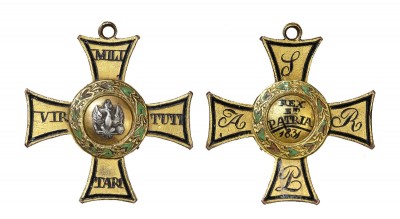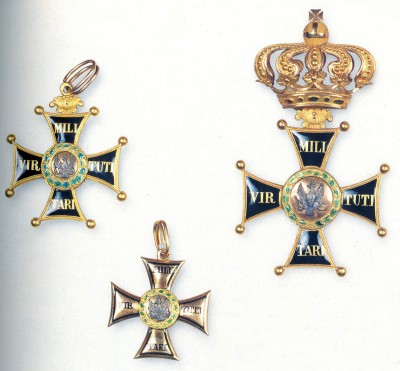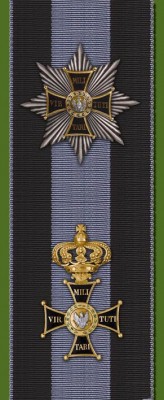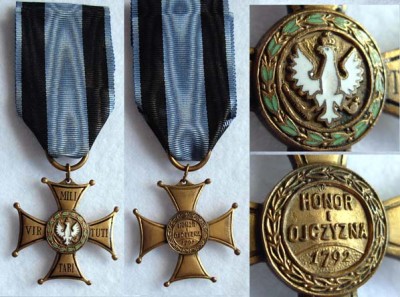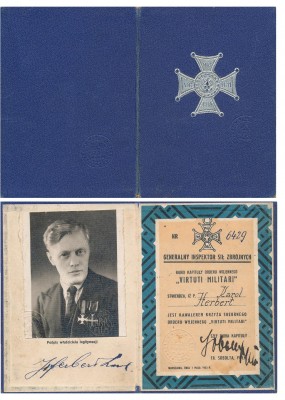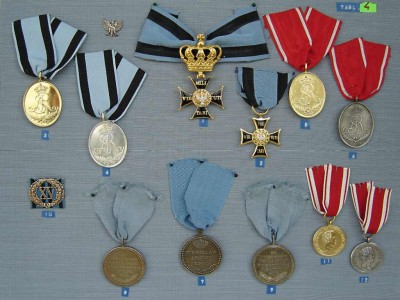| Název: Name: | Řád Virtuti Militari | Order Virtuti Military |
| Název v originále: Original Name: | Орден Виртути Милитари | |
| Datum vzniku: Date of Establishment: | DD.MM.1792 | |
| Datum zániku: Date of Termination: | DD.MM.RRRR | |
| Struktura: Structure: | Velkokříž řádu Komander rytíř Zlatý kříž Stříbrný kříž | - |
| Poznámka: Note: | - | - |
| Zdroje: Sources: | Dr. Wesolowski is the author of THE POLISH ORDERS, MEDALS, BADGES AND INSIGNIA, 1705-1985 and THE POLISH ORDER OF THE VIRTUTI MILITARI AND ITS CAVALIERS, 1792-1992 Шишков С. С. «Награды России. 1698-1917 гг.», Т. 3. И.Г. Спасский : Иностранные и Русслие Ордена до 1917 года .ИздаватЪелство государственного Ермитажа. Ленинград 1963 | |
Řád Virtuti Militari
Order Virtuti Military
Rad Virtuti Militari
Орден Виртути Милитари
The Order of Virtuti Militari
(Order of Virtuti Militari)
Founded 31.12.1831 by Mikulas I. The badge was a faithful copy of the Polish Order of Virtuti Militari, differing only in the missing balls at the ends of the arms of the cross. On the reverse, it replaced the circular plate bearing the emblem "Pogoń " ( Lithuanian emblem - a figure of a rider with a drawn sword), the plate bearing the inscription REX ET PATRIA (Latin for King and Country) with the year 1831. Despite the similarity in appearance and name, the decoration can in no way be considered as a continuity of the Polish Order of Virtuti Militari although it is included under that name in the system of Tsarist decorations.
According to Polish sources, it was only a commemorative badge with the name - Polish Badge of Honour and its purpose was to humiliate and degrade the Polish Order.
The order, along with the medal For the capture of Warsaw by storm in 1831, was awarded to soldiers of the intervening Russian army for suppressing the anti-Russian November Russian uprising in Poland.
It was the youngest of the Tsarist Russian orders , practical it was only awarded in 1831 and its validity in the Tsarist decorations system ended in 1835 .
The order was suspended from the blue and black ribbon of the Polish Order of Virtuti Militari.
Sources:
Frantisek Lobkowicz, Encyclopedia of Orders and Decorations, Libri 1999 ISBN: 80-85983-71-0
Wanda Bigoszewska, Polskie ordery i odznaczenia, Interpress Warszawa 1989 ISBN 83-223-2287-9
Tadeusz Jeziorowski, Order wojenny Virtuti Militari, Poznań, National Museum 1993; ISBN 83-85296-17-4
http://z.pilatowicz.webpark.pl/historia.htm
pl.wikipedia.org
http://medalirus.narod.ru/Nag19_20/Wa1n1/389.htm
(Order of Virtuti Militari)
Founded 31.12.1831 by Mikulas I. The badge was a faithful copy of the Polish Order of Virtuti Militari, differing only in the missing balls at the ends of the arms of the cross. On the reverse, it replaced the circular plate bearing the emblem "Pogoń " ( Lithuanian emblem - a figure of a rider with a drawn sword), the plate bearing the inscription REX ET PATRIA (Latin for King and Country) with the year 1831. Despite the similarity in appearance and name, the decoration can in no way be considered as a continuity of the Polish Order of Virtuti Militari although it is included under that name in the system of Tsarist decorations.
According to Polish sources, it was only a commemorative badge with the name - Polish Badge of Honour and its purpose was to humiliate and degrade the Polish Order.
The order, along with the medal For the capture of Warsaw by storm in 1831, was awarded to soldiers of the intervening Russian army for suppressing the anti-Russian November Russian uprising in Poland.
It was the youngest of the Tsarist Russian orders , practical it was only awarded in 1831 and its validity in the Tsarist decorations system ended in 1835 .
The order was suspended from the blue and black ribbon of the Polish Order of Virtuti Militari.
Sources:
Frantisek Lobkowicz, Encyclopedia of Orders and Decorations, Libri 1999 ISBN: 80-85983-71-0
Wanda Bigoszewska, Polskie ordery i odznaczenia, Interpress Warszawa 1989 ISBN 83-223-2287-9
Tadeusz Jeziorowski, Order wojenny Virtuti Militari, Poznań, National Museum 1993; ISBN 83-85296-17-4
http://z.pilatowicz.webpark.pl/historia.htm
pl.wikipedia.org
http://medalirus.narod.ru/Nag19_20/Wa1n1/389.htm
Reklama
Obverse and reverse of the Russian Virtuti Militari order of 1831.
Photo: http://medalirus.narod.ru/Nag19_20/Wa1n1/389.htm
Photo: http://medalirus.narod.ru/Nag19_20/Wa1n1/389.htm
By June 1835, when the badge was awarded, around 106,000 decorations of all classes had been distributed (according to the division of the Order Virtuti Militari). Of this, the 1st class ( which retained the ancient Polish appearance - that is, the Grand Cross with Star) was awarded as many as fourteen !
Number of decorations awarded by class:
Source:
Puchalski Zbigniew; Wojciechowski Ireneusz , Ordery i odznaczenia polskie i ich kawalerowie. Warsaw, Krajowa Agencja Wydawnicza, 1987. ISBN83-03-02143-5
Number of decorations awarded by class:
| Class: | Number: |
| 1st Class Grand Cross with Star (Krzyż Wielki z Gwiazdą) | 14 |
| 2nd Class Commander (Krzyż Komandorski) | 188 |
| Third Class Knight (Krzyż Kawalerski) | 1105 |
| IV. class Golden Cross (Krzyż Złoty) | 5219 |
| V. class Silver Cross (Krzyż Srebrny) | 100 000 |
Source:
Puchalski Zbigniew; Wojciechowski Ireneusz , Ordery i odznaczenia polskie i ich kawalerowie. Warsaw, Krajowa Agencja Wydawnicza, 1987. ISBN83-03-02143-5
This post has not been translated to English yet. Please use the TRANSLATE button above to see machine translation of this post.
Орден «Виртути Милитари» (военного достоинства)
Order «Виртути Милитари»
Vznešený, starobylý Polský řád Virtuti Militari můžeme svým významem přirovnat k nejvýznačnějším evropským řádům kam právem řadíme např. náš slavný Vojenský řád Marie Terezie, Ruský vojenský řád Svatého Jiří, Pruský řád Pour le Merité, Saský řád Sv. Jindřicha a další.
Řád byl založen v roce 1792 polským králem Stanislavem Augustem jako nejvyšší odměna za statečnost v poli, pro ty chrabré důstojníky, kteří se vyznamenali ve válce s Ruskem. Prvním typem tohoto řádu byla oválná zlatá či stříbrná medaile. Ve Varšavské mincovně bylo vyrobeno 65 zlatých a 290 stříbrných dekorací (skutečně bylo uděleno 20 zlatých a 40 stříbrných medailí). Mezi generály nacházíme slavná jména jako např. J. Poniatowského a T. Kosciuska.
Tyto medaile jsou posléze převedeny do tvaru klasického řádu, který se člení do pěti stupňů. Poslední řádové stupně, zlatý a stříbrný kříž jsou vyhrazeny pro poddůstojníky a mužstvo za mimořádné projevy statečnosti a odvahy. Řád však existoval velmi krátkou dobu neboť polský král se již roku 1792 připojuje k Targovické konfederaci, podporuje Rusko a řád ruší.
V roce 1794 bylo dokonce zakázáno tento řád nosit na stejnokroji či oděvu.
V roce 1807 po uzavření míru v Tylži císař Napoleon povolil, či prosadil vytvoření území, známé jako Varšavské vévodství, obnovil některá stará polská privilegia, ale i řády. Fridrich August se stává velmistrem všech těchto řádů a se souhlasem císaře Napoleona používá titul král Polska. V roce 1808 dochází k malé změně reversu řádového kříže, na žádost cara Alexandra I. mizí litevský erb (Litva byla součástí říše) a je nahrazen nápisem "Rex et Patria" (král a vlast) letopočet 1792 je však zachován.
Porážka Napoleon znamenala i konec Varšavského vévodství, ale i stávajících polských řádů. Situace se mění v roce 1815 po přistoupení (jiný termín pro správné slovo okupace) Polska k carskému Rusku. Car Alexandr, který do svých titulů zahrnul i titul polského krále se projevil jako rozumný politik a svým výnosem obnovuje, jak řád Virtuti Militari, tak i řád Sv. Stanislava a řád Bílého orla. Alexandr dokonce odmítl velkokříž řádu Virtuti Militari s tím,že je vyhrazen těm nejlepším vojevůdcům a spokojil se s velkodůstojníkem tohoto řádu. Car dokonce povolil nošení řádových dekorací vojákům, kteří bojovali v armádě císaře Napoleon, ale Alexandr zároveň tento řád v lásce neměl a také jej neuděloval.
Masové(inflační) udělení řádu v jeho nejnižším stupni se přímo vztahuje k roku 1831. Dne 7.listopadu 1831 po porážce polského povstání svým výnosem rozhodl car udělit poslední stupeň řádového kříže všem vojákům, kteří se podíleli na těchto bojích a postavil tak řádový stupeň na úroveň pamětní medaile.
Vyššími stupni řádu však jsou vyznamenaní přední generálové, velitele jednotek, kteří se na těchto bojích se v roce 1831 svými jednotkami podíleli:
- Velkokníže Michail Pavlovič obdržel řád v 1. stupni ( velkokříž
- Generál I.R. Anrep-Elmet 2.stupeň
- S.F. Apraskin 2.st.
- F.F. Berg 2.st.
- K.I. Bistrom 1.stupeň
- P.F. Vejmarn 2.st.
- M.G.Vlasov 2.st.
- K.E. Wrangel 3.st
- E.A. Golovin 2.st.
- I. F. Paskievič 1.stupeň
Literatura uvádí další vysoké armádní důstojníky:
Generální ubytovatel armády A.I. Nejdgart ze své vysoké armádní funkce doporučil další ocenění generálů I.I.Dena, generála pěchoty K.F.Tola (1.st), generála A.G. Šerbatova a mnoho dalších důstojníků se mohlo pyšnit tímto starobylým vojenským řádem.
Literatura:
Dr. Wesolowski is the author of THE POLISH ORDERS, MEDALS, BADGES AND INSIGNIA, 1705-1985 and THE POLISH ORDER OF THE VIRTUTI MILITARI AND ITS CAVALIERS, 1792-1992
Шишков С. С. «Награды России. 1698-1917 гг.», Т. 3.
И.Г. Спасский : Иностранные и Русслие Ордена до 1917 года .ИздаватЪелство государственного Ермитажа. Ленинград 1963
forum.valka.cz
forum.valka.cz
Poznámka:
Odkaz na zásadní a kvalitní článek kolegy Zbycha je pohled polského historika. Mé zpracování vychází z ruské historie. Závěr je na každém čtenáři.
Reklama
II.part:
Wirtuti Militari:
The Order Jewel of the 1st degree was reserved for the highest commanders, generals of at least the rank of army corps, who won a decisive battle. These conditions of the award are also known, for example, in the Order of St. George.
Description of the 1st degree:
Anside:
Gold cross with slightly flared arms, which are decorated with gold balls. The arms of the cross are enamelled in black with an unfolded order motto:
"Virtuti militari".
In the central medallion, a crowned Polish eagle with a royal scepter and an apple (symbol of the Kingdom of Poland) is loaded, framed by a green enamel wreath. The royal cross is surmounted by a royal crown (as stated by Russian phalierists) of European type.
Reverses:
On the back, in the central medallion, there is a smaller inscription:
"Rex et Patria" and the date: "1831" (for the Polish edition here is the date of the Order's foundation 1792)
On the arms of the cross are spaced the letters:
"SARP" (Stanislaw August King of Poland)
The Order of Virtuti Militari 1. The Order of the Order of the Order of the Virtue of the First Degree is correctly understood as a Grand Cross, and so initially it was worn over the shoulder and the jewel was suspended from the Grand Cross. But on January 3, 1832, by the Tsar's decision, the Order was worn on a necklace ribbon, this Tsarist arbitrariness was to reduce the importance of the Order in the eyes of the generals and the whole society.
An integral part of the Order of the 1st degree was the eight-pointed silver Order star with the cross "Virtuti militari" loaded on its center. The star was worn on the left side of the chest below all the other Order stars.
The Order of Virtuti Militari, the jewel of the 2nd degree:
The Order in the 2nd degree was intended for other generals for victory in battle, for bravery and exemplary leadership of their unit, which contributed decisively to a partial victory. The actual jewel differs from the 1st degree only in being somewhat smaller in size, being worn as a necklace decoration, without the addition of the Order's star.
The Order of Virtuti Militari, 3rd degree jewel
The Order in its 3rd degree was reserved for senior officers of the army for demonstrated bravery, outstanding leadership of the unit. It is similar to the 2nd degree cross, but the cross is not surmounted by a crown and is worn on a flowing ribbon on the chest.
The Order of Virtuti Militari, Jewel of the 4th degree
The 4th degree decoration was reserved for junior officers at the company-battalion level and, after 19 January 1831, for all other senior officers of the Russian Army. The gold cross measures 28x28 mm with black enamelling at the edge. The royal eagle is loaded on a red central medallion. The cross was worn on a flowing ribbon on the chest.
The Order of Virtuti Militari, Jewel of the 5th degree
The Order in its last fifth degree was intended For bravery to officers. It was similar to the fourth degree, all but a silver cross measuring 28x28 mm. The last blow to this order was struck on 19 November 1831 when a tsarist decree decreed that the last degree of the order would be awarded to all privates and non-commissioned officers and, as Russian literature literally states, to medics and barbers (tsiryulniks), and from 15.
On August 20, 1842, it was decided to discontinue the award of this order to members of the Russian army with the date of December 1, 1842.January 1843
Another Tsar's decree of 2 May 1857 suspended the order in its last degree to the level of commemorative medals and decided that it would be worn on the cradle in the order as is customary for medals in general.
On the Polish side, for soldiers fighting Russian troops, the order was awarded in the old design with the coat of arms of Lithuania and the year 1792.
STATISTICS:
The Grand Cross of the order was not awarded.
Only the division commander, Major General Josef Drevnicky, received the Grand Cross. The other numbers are as follows:
- Commander of the Order 105 pcs
- Gold Cross 1794 pcs
- Silver Cross 1963 pcs
Note:
In the Russian environment the Order is divided into degrees. The division of the Order in Poland is classical:
- Grand Cross
- Commander
- Knight
- Golden Cross
- Silver Cross
In Russia the rest of the Order's jewels are melted down and the awarding of the Order is terminated. After 90 years of "silence" and efforts to forget, the Order is restored in 1918 and on the occasion of the victorious war with the Bolsheviks, 25 Polish officers who distinguished themselves by valour and bravery in the battles of that war are decorated on 7 August 1920.
In 1939, after the unfortunate war and the defeat of Poland, when brave Poles fought at the front against Wehrmacht and Russian Army units, the end of free Poland and the Order of Virtuti Militari. But already in exile, the Order is restored and rarely awarded to brave Poles on the battlefields of the Middle East, to fighters in Europe and especially to airmen. On the Eastern Front, the Order is awarded to several officers at the Battle of Lenin, but in 1945 this Order with its rich tradition also adorns the chest of Red Army officers.
Note:
This brief account of the great Order makes no pretensions to a comprehensive view of the history of the Order. The interested reader should be referred to the fine Polish literature already in general use.
In 1939 the Order was abolished again, and again only at the end of the Second World War. At this time, gentlemen military awards, along with the Poles were hundreds of Soviet soldiers who distinguished themselves in the liberation of Poland from German occupation.
Conclusion:
Overview of the awarding of the Order of Virtuti Militari:
- l. edition from the period 1792-1794
- II. edition from the period 1806-1815
- III. edition from the period 1815-1831
- IV. edition from the period l1918-1939
- V. edition from the period 1939-1945
- VI. Edition from 1943-1989
- VII. Edition after 1989
Literature:
Spassky I.Г. Foreign and Russian orders before 1917. L. 1963.
Shishkov S. С. "Awards of Russia. 1698-1917", Vol. 3.
http://www.awardrp.narod.ru/history.htm
Wirtuti Militari:
The Order Jewel of the 1st degree was reserved for the highest commanders, generals of at least the rank of army corps, who won a decisive battle. These conditions of the award are also known, for example, in the Order of St. George.
Description of the 1st degree:
Anside:
Gold cross with slightly flared arms, which are decorated with gold balls. The arms of the cross are enamelled in black with an unfolded order motto:
"Virtuti militari".
In the central medallion, a crowned Polish eagle with a royal scepter and an apple (symbol of the Kingdom of Poland) is loaded, framed by a green enamel wreath. The royal cross is surmounted by a royal crown (as stated by Russian phalierists) of European type.
Reverses:
On the back, in the central medallion, there is a smaller inscription:
"Rex et Patria" and the date: "1831" (for the Polish edition here is the date of the Order's foundation 1792)
On the arms of the cross are spaced the letters:
"SARP" (Stanislaw August King of Poland)
The Order of Virtuti Militari 1. The Order of the Order of the Order of the Virtue of the First Degree is correctly understood as a Grand Cross, and so initially it was worn over the shoulder and the jewel was suspended from the Grand Cross. But on January 3, 1832, by the Tsar's decision, the Order was worn on a necklace ribbon, this Tsarist arbitrariness was to reduce the importance of the Order in the eyes of the generals and the whole society.
An integral part of the Order of the 1st degree was the eight-pointed silver Order star with the cross "Virtuti militari" loaded on its center. The star was worn on the left side of the chest below all the other Order stars.
The Order of Virtuti Militari, the jewel of the 2nd degree:
The Order in the 2nd degree was intended for other generals for victory in battle, for bravery and exemplary leadership of their unit, which contributed decisively to a partial victory. The actual jewel differs from the 1st degree only in being somewhat smaller in size, being worn as a necklace decoration, without the addition of the Order's star.
The Order of Virtuti Militari, 3rd degree jewel
The Order in its 3rd degree was reserved for senior officers of the army for demonstrated bravery, outstanding leadership of the unit. It is similar to the 2nd degree cross, but the cross is not surmounted by a crown and is worn on a flowing ribbon on the chest.
The Order of Virtuti Militari, Jewel of the 4th degree
The 4th degree decoration was reserved for junior officers at the company-battalion level and, after 19 January 1831, for all other senior officers of the Russian Army. The gold cross measures 28x28 mm with black enamelling at the edge. The royal eagle is loaded on a red central medallion. The cross was worn on a flowing ribbon on the chest.
The Order of Virtuti Militari, Jewel of the 5th degree
The Order in its last fifth degree was intended For bravery to officers. It was similar to the fourth degree, all but a silver cross measuring 28x28 mm. The last blow to this order was struck on 19 November 1831 when a tsarist decree decreed that the last degree of the order would be awarded to all privates and non-commissioned officers and, as Russian literature literally states, to medics and barbers (tsiryulniks), and from 15.
On August 20, 1842, it was decided to discontinue the award of this order to members of the Russian army with the date of December 1, 1842.January 1843
Another Tsar's decree of 2 May 1857 suspended the order in its last degree to the level of commemorative medals and decided that it would be worn on the cradle in the order as is customary for medals in general.
On the Polish side, for soldiers fighting Russian troops, the order was awarded in the old design with the coat of arms of Lithuania and the year 1792.
STATISTICS:
The Grand Cross of the order was not awarded.
Only the division commander, Major General Josef Drevnicky, received the Grand Cross. The other numbers are as follows:
- Commander of the Order 105 pcs
- Gold Cross 1794 pcs
- Silver Cross 1963 pcs
Note:
In the Russian environment the Order is divided into degrees. The division of the Order in Poland is classical:
- Grand Cross
- Commander
- Knight
- Golden Cross
- Silver Cross
In Russia the rest of the Order's jewels are melted down and the awarding of the Order is terminated. After 90 years of "silence" and efforts to forget, the Order is restored in 1918 and on the occasion of the victorious war with the Bolsheviks, 25 Polish officers who distinguished themselves by valour and bravery in the battles of that war are decorated on 7 August 1920.
In 1939, after the unfortunate war and the defeat of Poland, when brave Poles fought at the front against Wehrmacht and Russian Army units, the end of free Poland and the Order of Virtuti Militari. But already in exile, the Order is restored and rarely awarded to brave Poles on the battlefields of the Middle East, to fighters in Europe and especially to airmen. On the Eastern Front, the Order is awarded to several officers at the Battle of Lenin, but in 1945 this Order with its rich tradition also adorns the chest of Red Army officers.
Note:
This brief account of the great Order makes no pretensions to a comprehensive view of the history of the Order. The interested reader should be referred to the fine Polish literature already in general use.
In 1939 the Order was abolished again, and again only at the end of the Second World War. At this time, gentlemen military awards, along with the Poles were hundreds of Soviet soldiers who distinguished themselves in the liberation of Poland from German occupation.
Conclusion:
Overview of the awarding of the Order of Virtuti Militari:
- l. edition from the period 1792-1794
- II. edition from the period 1806-1815
- III. edition from the period 1815-1831
- IV. edition from the period l1918-1939
- V. edition from the period 1939-1945
- VI. Edition from 1943-1989
- VII. Edition after 1989
Literature:
Spassky I.Г. Foreign and Russian orders before 1917. L. 1963.
Shishkov S. С. "Awards of Russia. 1698-1917", Vol. 3.
http://www.awardrp.narod.ru/history.htm
Join us
We believe that there are people with different interests and experiences who could contribute their knowledge and ideas. If you love military history and have experience in historical research, writing articles, editing text, moderating, creating images, graphics or videos, or simply have a desire to contribute to our unique system, you can join us and help us create content that will be interesting and beneficial to other readers.
Find out more